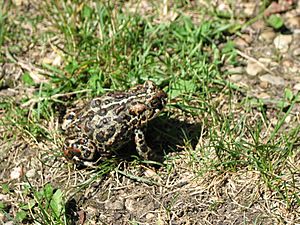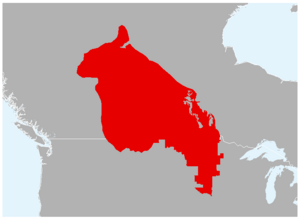Canadian toad facts for kids
Quick facts for kids Canadian toad |
|
|---|---|
 |
|
| Canadian toad at Wagner Natural Area, Alberta | |
| Conservation status | |
| Scientific classification | |
| Genus: |
Anaxyrus
|
| Species: |
hemiophrys
|
 |
|
| Canadian toad range | |
| Synonyms | |
|
Bufo hemiophrys Cope, 1886 |
|
The Canadian toad (also called the Dakota toad) is a type of toad found in the prairie areas of central Canada and parts of the United States. Its scientific name is Anaxyrus hemiophrys. It belongs to the family Bufonidae, which are known as the "true" toads.
The name hemiophrys comes from a Latin word meaning "eyebrow." This refers to the noticeable ridges, called cranial crests, that are found between and behind its eyes. Like other true toads, the Canadian toad has no tail or teeth. It has horizontal pupils and dry, thick, warty skin.
Contents
Canadian Toad Description
The Canadian toad can grow to about 7.6 cm (3 in) long. Adult males are usually 5.6 to 6.9 cm (2.2–2.7 in). Females are a bit larger, from 5.6 to 7.9 cm (2.2–3.1 in). They weigh between 35 and 55 grams.
Their skin is usually brown. They have a yellowish line down the middle of their back. On each side of this line, there are two or three rows of brown spots. Each spot has one or two small bumps, called tubercles, which are often reddish. They also have spots on their upper lip and near their ear drum, called the tympanum.
The Canadian toad has a special gland behind its eye called the parotid gland. This gland releases a mild toxin to protect the toad from animals that might try to eat it. This toxin can irritate eyes and mouths. If an animal eats it, it can cause illness. However, these toads are generally safe for humans to handle.
One way to tell a Canadian toad apart from its close relative, the American toad (Anaxyrus americanus), is by looking at the ridges on its head. The Canadian toad has ridges between its eyes that are close together and form a bump. The American toad has ridges that are more separated and join other ridges at a right angle.
Canadian Toad Classification
The Canadian toad was first described in 1886 by a scientist named Edward Drinker Cope. He gave it the scientific name Bufo hemiophrys. Cope studied its body features and compared it to other toad species. He noticed that the Canadian toad was different because it didn't have certain ridges behind its eyes and had spots on its belly.
Another toad, the Wyoming toad (Anaxyrus baxteri), was once thought to be a type of Canadian toad. Scientists now know it's a separate species. It's believed to be a small group left over from a time when the Canadian toad's ancestors lived in a much larger area.
The Canadian toad lives in a large area, but its numbers have been decreasing in southern Alberta, Canada. In Canada, they live in a small part of the southern Northwest Territories. They also live across eastern and central Alberta, most of Saskatchewan, and southwestern Manitoba. In the United States, their home range includes northern Montana, North Dakota, the northeastern part of South Dakota, and northwestern Minnesota.
Canadian Toad Ecology
Diet
Baby Canadian toads, called tadpoles, live in the water. They eat tiny bits of plants and other nutrients by filtering the water. Young toads mostly eat small ground-dwelling beetles.
Adult Canadian toads mainly eat insects. Their favorite foods are beetles and Hymenoptera (which include ants, bees, wasps, and sawflies). They also eat a small number of spiders.
Reproduction
Canadian toads usually start breeding in late April or early May, and they continue until August or September. They breed in water. The male toad holds onto the female in a process called amplexus. The female lays her eggs in shallow water, and the male fertilizes them as they are laid.
The eggs are laid in lakes, ponds, and other watery places. These spots often have plant debris, new grass, or cattails. This helps protect the eggs from being washed away and provides food for the tadpoles when they hatch.
Life cycle
A female Canadian toad can lay strings of up to 6,000 eggs at a time. She can lay up to 20,000 eggs each year! The eggs hatch in about four to five days.
The tadpoles live in the water for 7 to 11 weeks. During this time, they change into young toads through a process called metamorphosis. They eat plant nutrients from the water. Young toads often stay close to the water where they were born and can be found in large groups.
Adult Canadian toads live near lakes, streams, irrigation ditches, and wetlands. Males become adults around one year old, and females at two years old. They can live for 7 to 12 years.
Torpor (Hibernation)
Canadian toads start their winter sleep, called torpor (or hibernation), as early as late August. They dig into the earth and create small holes to sleep in. These spots can create small mounds in the ground, sometimes called mima mounds. Hundreds of toads might sleep together in one of these mounds.
They stay underground throughout the fall and winter, digging deeper as the soil gets colder. Each toad usually picks the same spot to hibernate every year. They come out of their burrows once the soil thaws and they can dig their way out.
- Pauly, G. B., D. M. Hillis, and D. C. Cannatella. (2004) The history of a Nearctic colonization: Molecular phylogenetics and biogeography of the Nearctic toads (Bufo). Evolution 58: 2517–2535.
- Green, D. M. (1983) Allozyme Variation through a Clinal Hybrid Zone between the Toads Bufo americanus and B. hemiophrys in Southeastern Manitoba, Herpetologica, Vol. 39, pp. 28–40, Stable URL: https://www.jstor.org/stable/3892473
- Moore, J. E., & Strickland, E. H. (1954) Notes on the Food of Three Species of Alberta Amphibians, American Midland Naturalist, Vol. 52, No. 1 pp. 221–224 URL: https://www.jstor.org/stable/2422059
- Cogger, H. G., & Zweifel, R.G. Encyclopedia of Reptiles and Amphibians. San Diego: Academic Press., 1998
- Lannoo, M. J. Amphibian Declines: The Conservation Status of United States Species, University of California Press, 2005
- Cope, E. D. (1886) Synonymic List of the North American Species of Bufo and Rana, with Descriptions of Some New Species of Batrachia, from Specimens in the National Museum, Proceedings of the American Philosophical Society, Vol. 23, No. 124 (Dec., 1886), pp. 514–526, Stable URL: https://www.jstor.org/stable/983330
- Smith, H. M., Chiszar, D., Collins, J. T., Van Breukelen, F. (1998) The Taxonomic Status of the Wyoming Toad, Bufo baxteri Porter, Contemporary Herpetology, vol. 1, (Jan., 1998), Stable URL: https://web.archive.org/web/20110725194859/http://www.contemporaryherpetology.org/ch/1998/1/CH_1998_1.pdf
- Taylor, S. K., Williams., E. S., & Mills, K. W. (1999) Mortality of Captive Canadian Toads from Basidiobolus ranarum Mycotic Dermatitis, Journal of Wildlife Diseases, 35(1), 1999, pp. 64–69
- Feder, M. E. & Burggren, W. W. (1993) Environmental Physiology of the Amphibians, The Quarterly Review of Biology, September 1993, vol. 68, no. 3
- Eaton, B. R., Paszkowski, C. E., Kristensen, K., Hiltz, M. (2005) Life-history variation among populations of Canadian Toads in Alberta, Canada, Canadian Journal of Zoology 83(11): 1421–1430 (2005)
- Hamilton, I.A., Skilnick, J.L., Troughton, H., Russell, A.P. & Powell, G.L. (1998). Status of the Canadian toad (Bufo hemiophrys) in Alberta. Alberta Wildlife Status Report No. 12, Alberta Environmental Protection, Wildlife Management Division, and the Alberta Conservation Association, Edmonton, AB.
- Wittliff, J. L. (1962) Parotoid Gland Secretions in Two Species Groups of Toads (Genus Bufo). Evolution, Vol. 16, No. 2 (Jun., 1962), pp. 143–153 Stable URL: https://www.jstor.org/stable/2406193
See also
 In Spanish: Sapo canadiense para niños
In Spanish: Sapo canadiense para niños


